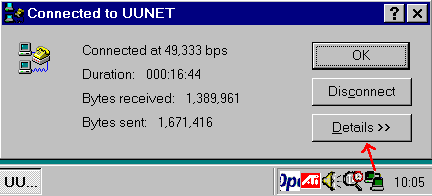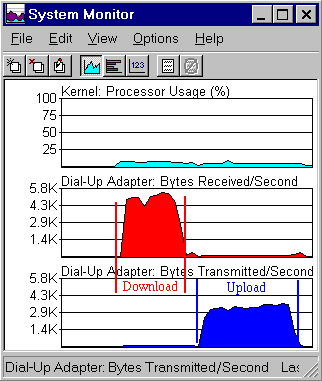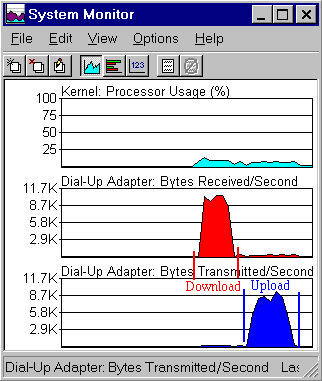There has been over the last years a major improvement in speeds of
modems: coming from a 300 Baud Acoustic couplers going to 2400, 4800,
9600, then 14.400 and 28.800 to 33.600 Baud to the current 56K modems
according to the V.90 standard, as they have become the standard for modem
connections to the Internet.
But a 56K V.90 modem is not always having a throughput of 56.000 bit per
second (although it can exceed in some special cases that limit).
When establishing the connection (for example to an Internet provider), the
modem is testing the quality of the phone-line and will select the fastest
possible speed:
Even on good connections, you are very rarely able to connect with higher
speeds than 49.333 Bit per Seconds.
As an example, I have made a download (from the Internet to my PC) and
an Upload (from my PC to the Internet) of a 250 KByte ZIP-file:
 | During the Download, the throughput is very close to the above listed connection speed (of approx. 5 KByte per second). But the Upload only gets a throughput of approx 3.3 Kbyte per second. |
This is caused by the very special design of the V.90 modem standard,
which was specially designed for Internet connections, where most data
is downloaded to your PC and only limited data is uploaded:
The modem at your ISP is connected to a digital line (an ISDN line) and
includes a 56K-host module, allowing to transmit data at up to 56 K.
The modem in your PC includes a 56k-client module, able to receive data
up to 56 K.
For uploading data (from your PC to the Internet), V90 modems include
a V.34-module for speeds up to 33.600 Bit per second.
This explains the download speed (shown above) of approx. 5 KByte per second
and the slower upload at approx. 3.3 KByte per second.
For the above throughput test, I used a ZIP-file.
When using a text-files of the same size, the throughput is different:
 | The download throughput is almost 10 Kbyte per second, the upload is approx. 7.5 KByte per second. The modems are able to get this higher speed by compressing the data |
The above explains, why you will be limited to maximum 33.600 bit per second
as connection speed, when using a V.90-modem to connect to another V.90
modem (for example at your company server):
The regular V.90-modems include ONLY the 56K-client module, allowing
to receive data at speeds up to 56.000 bit per second. When using such a
modem at your server for dialing-in, the modem will not work as V.90
host (since it is missing the 56k-Host-module), therefor the connection will
be establish only at the V.34-standard with maximum 33.600 bit per second.
If you like to offer your users a download speed of up to 56.000 bit per second,
you will need to use the same technology as an Internet Service Provider (ISP):
– a digital (ISDN) phone-line
– an ISDN-modem with 56K-Host Module (example: the 3COM/USR I-modem)



